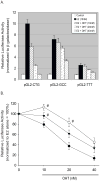The tri-nucleotide spacer sequence between estrogen response element half-sites is conserved and modulates ERalpha-mediated transcriptional responses
- PMID: 20403436
- PMCID: PMC2891080
- DOI: 10.1016/j.jsbmb.2010.04.009
The tri-nucleotide spacer sequence between estrogen response element half-sites is conserved and modulates ERalpha-mediated transcriptional responses
Abstract
The estrogen response element (ERE) consensus sequence is AGGTCAnnnTGACCT, where nnn is known as the tri-nucleotide spacer sequence. Studying 1017 high-confidence ERalpha-bound loci, we found that genomic EREs are enriched for spacers composed of C(A/T)G, suggesting that the spacer may influence receptor binding and transcriptional responses. We designed consensus EREs containing variable spacer sequences and compared ERalpha binding in gel shift assays and enhancer function in reporter assays. We found that ERalpha-ERE binding affinity is modulated by the tri-nucleotide spacer sequence and is favored by spacer sequences of CTG>GCC>TTT. Similarly, luciferase reporter assays indicated that the estrogen-stimulated transcriptional response is modulated by the spacer and parallels the gel shift data: CTG>GCC>TTT. Reporter assays demonstrated that the spacer sequence also modulates the sensitivity of EREs to repression engendered by the receptor antagonist hydroxytamoxifen. These experiments indicate that the sequence of the tri-nucleotide spacer is non-random at receptor-bound genomic loci, influences ERalpha-DNA-binding affinity, and modulates transactivation potential of the receptor-ligand-DNA complex. This work has implications for understanding which genomic EREs are targeted by ERalpha, should improve computational prediction of functional EREs within genomic sequences, and describes novel sequence determinants of the estrogen response.
Copyright 2010 Elsevier Ltd. All rights reserved.
Figures




Similar articles
-
Intercalation of XR5944 with the estrogen response element is modulated by the tri-nucleotide spacer sequence between half-sites.J Steroid Biochem Mol Biol. 2011 Apr;124(3-5):121-7. doi: 10.1016/j.jsbmb.2011.02.003. Epub 2011 Feb 17. J Steroid Biochem Mol Biol. 2011. PMID: 21333738 Free PMC article.
-
Location analysis for the estrogen receptor-alpha reveals binding to diverse ERE sequences and widespread binding within repetitive DNA elements.Nucleic Acids Res. 2010 Apr;38(7):2355-68. doi: 10.1093/nar/gkp1188. Epub 2010 Jan 4. Nucleic Acids Res. 2010. PMID: 20047966 Free PMC article.
-
Estrogen response element sequence impacts the conformation and transcriptional activity of estrogen receptor alpha.Mol Cell Endocrinol. 2001 Mar 28;174(1-2):151-66. doi: 10.1016/s0303-7207(01)00382-3. Mol Cell Endocrinol. 2001. PMID: 11306182
-
Estrogen response element-dependent regulation of transcriptional activation of estrogen receptors alpha and beta by coactivators and corepressors.J Mol Endocrinol. 2004 Oct;33(2):387-410. doi: 10.1677/jme.1.01541. J Mol Endocrinol. 2004. PMID: 15525597
-
Estrogen receptor interaction with estrogen response elements.Nucleic Acids Res. 2001 Jul 15;29(14):2905-19. doi: 10.1093/nar/29.14.2905. Nucleic Acids Res. 2001. PMID: 11452016 Free PMC article. Review.
Cited by
-
DNA Recognition by a Novel Bis-Intercalator, Potent Anticancer Drug XR5944.Curr Top Med Chem. 2015;15(14):1385-97. doi: 10.2174/1568026615666150413155608. Curr Top Med Chem. 2015. PMID: 25866279 Free PMC article. Review.
-
From Influenza Virus Infections to Lupus: Synchronous Estrogen Receptor α and RNA Polymerase II Binding Within the Immunoglobulin Heavy Chain Locus.Viral Immunol. 2020 May;33(4):307-315. doi: 10.1089/vim.2019.0144. Epub 2020 Feb 27. Viral Immunol. 2020. PMID: 32105583 Free PMC article.
-
In-silico identification and functional validation of allele-dependent AR enhancers.Oncotarget. 2015 Mar 10;6(7):4816-28. doi: 10.18632/oncotarget.3019. Oncotarget. 2015. PMID: 25693204 Free PMC article.
-
Prognostic features of signal transducer and activator of transcription 3 in an ER(+) breast cancer model system.Cancer Inform. 2014 Jan 21;13:21-45. doi: 10.4137/CIN.S12493. eCollection 2014. Cancer Inform. 2014. PMID: 24526833 Free PMC article.
-
Intercalation of XR5944 with the estrogen response element is modulated by the tri-nucleotide spacer sequence between half-sites.J Steroid Biochem Mol Biol. 2011 Apr;124(3-5):121-7. doi: 10.1016/j.jsbmb.2011.02.003. Epub 2011 Feb 17. J Steroid Biochem Mol Biol. 2011. PMID: 21333738 Free PMC article.
References
-
- Yager JD, Davidson NE. Estrogen carcinogenesis in breast cancer. N Engl J Med. 2006;354(3):270–282. - PubMed
-
- Smith CL, O’Malley BW. Coregulator function: a key to understanding tissue specificity of selective receptor modulators. Endocr Rev. 2004;25(1):45–71. - PubMed
-
- Bjornstrom L, Sjoberg M. Mechanisms of estrogen receptor signaling: convergence of genomic and nongenomic actions on target genes. Mol Endocrinol. 2005;19(4):833–842. - PubMed
-
- Cerillo G, Rees A, Manchanda N, Reilly C, Brogan I, White A, Needham M. The oestrogen receptor regulates NFkappaB and AP-1 activity in a cell-specific manner. J Steroid Biochem Mol Biol. 1998;67(2):79–88. - PubMed
-
- Paech K, Webb P, Kuiper GG, Nilsson S, Gustafsson J, Kushner PJ, Scanlan TS. Differential ligand activation of estrogen receptors ERalpha and ERbeta at AP1 sites. Science. 1997;277(5331):1508–1510. - PubMed
Publication types
MeSH terms
Substances
Grants and funding
LinkOut - more resources
Full Text Sources

